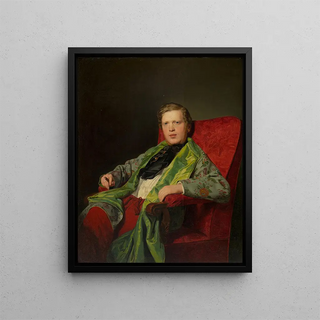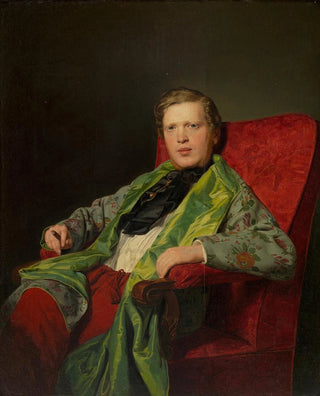Art print | Emanuel Ritter von Neuwall 1813-1879 - Ferdinand Georg Waldmüller


View from behind

Frame (optional)
In the vibrant panorama of 19th-century art, one work stands out for its emotional depth and striking realism: "Emanuel Ritter von Neuwall 1813-1879" by Ferdinand Georg Waldmüller. This painting, a true reflection of its era, immerses us in the intimate universe of a character whose life and journey are skillfully captured by the artist. Waldmüller, a master of portraiture, manages to transcend mere representation to offer a window into the human soul. Every brushstroke seems to whisper forgotten stories, and each gaze directed at the viewer evokes a timeless connection.
Style and uniqueness of the work
Waldmüller's work is distinguished by a style that combines realism and sensitivity. His technique, marked by meticulous attention to detail, reveals an exceptional mastery of light and shadow. In "Emanuel Ritter von Neuwall 1813-1879," the subject's face is illuminated with an almost tangible softness, while the background, subtly blurred, highlights the stature of the character. The colors, carefully chosen, oscillate between warm tones and cooler shades, creating an atmosphere that is both intimate and contemplative. Waldmüller does not merely depict his model; he breathes life into him, telling a story, revealing a personality. Every element of the composition, from clothing choices to posture, is designed to enhance the emotional impact of the art print, making the viewer a participant in this exploration of identity.
The artist and his influence
Ferdinand Georg Waldmüller, an emblematic figure of Austrian Romanticism, mastered the art of blending tradition and innovation throughout his career. Trained in accordance with academic techniques, he quickly distinguished himself with an innovative approach that prioritized direct observation of nature and human beings. Influenced by masters such as Rembrandt and Van Dyck, he developed a style that is uniquely his own, characterized by an increased sensitivity to human emotions. Waldmüller also played a key role in the evolution of genre painting, integrating

Matte finish

View from behind

Frame (optional)
In the vibrant panorama of 19th-century art, one work stands out for its emotional depth and striking realism: "Emanuel Ritter von Neuwall 1813-1879" by Ferdinand Georg Waldmüller. This painting, a true reflection of its era, immerses us in the intimate universe of a character whose life and journey are skillfully captured by the artist. Waldmüller, a master of portraiture, manages to transcend mere representation to offer a window into the human soul. Every brushstroke seems to whisper forgotten stories, and each gaze directed at the viewer evokes a timeless connection.
Style and uniqueness of the work
Waldmüller's work is distinguished by a style that combines realism and sensitivity. His technique, marked by meticulous attention to detail, reveals an exceptional mastery of light and shadow. In "Emanuel Ritter von Neuwall 1813-1879," the subject's face is illuminated with an almost tangible softness, while the background, subtly blurred, highlights the stature of the character. The colors, carefully chosen, oscillate between warm tones and cooler shades, creating an atmosphere that is both intimate and contemplative. Waldmüller does not merely depict his model; he breathes life into him, telling a story, revealing a personality. Every element of the composition, from clothing choices to posture, is designed to enhance the emotional impact of the art print, making the viewer a participant in this exploration of identity.
The artist and his influence
Ferdinand Georg Waldmüller, an emblematic figure of Austrian Romanticism, mastered the art of blending tradition and innovation throughout his career. Trained in accordance with academic techniques, he quickly distinguished himself with an innovative approach that prioritized direct observation of nature and human beings. Influenced by masters such as Rembrandt and Van Dyck, he developed a style that is uniquely his own, characterized by an increased sensitivity to human emotions. Waldmüller also played a key role in the evolution of genre painting, integrating






